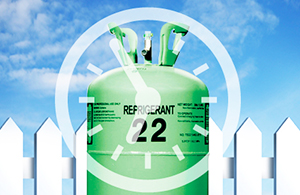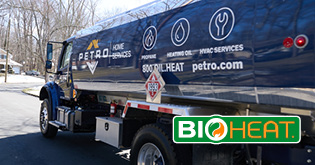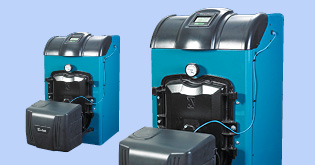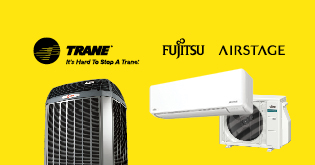- My Account:
- Sign In
- Register
- Make Payment

R22 refrigerant replacement: Your 2025 guide to the latest HVAC changes.

If your home’s air conditioning system is over a decade old, it likely uses R22 refrigerant—a chemical phased out due to its harmful effects on the ozone layer. But as of 2025, the landscape for refrigerants in home cooling systems has changed even more. Here’s what you need to know about R22 replacement, the latest regulations, and your best options moving forward.
Your local HVAC pros at Petro Home Services can answer your questions about R22 replacement services and air conditioning systems. We have EPA-certified technicians on-hand to discuss your needs and options, including R22 refrigerant draining.
Call 888.735.5651 to learn more about your R22 refrigerant replacement options.
What is R22?
R22 refrigerant has been used for years in central air conditioners, heat pumps, mini-splits, car AC systems, and other refrigeration equipment. It’s the key to absorbing and removing heat from a space.
Why is R22 being phased out?
R22, also known as HCFC-22, was once the standard refrigerant in residential air conditioning. However, due to its ozone-depleting properties, the U.S. Environmental Protection Agency (EPA) banned the production and import of R22 on January 1, 2020. Since then, only recycled or reclaimed R22 has been available for servicing existing systems, making repairs more challenging.
2025 update: New rules for refrigerants.
The EPA’s regulations didn’t stop with R22. As of January 1, 2025, new rules under the American Innovation and Manufacturing (AIM) Act have further transformed the HVAC industry:
R410A, the common replacement for R22, is now also being phased out for new systems∙••• due to its high Global Warming Potential (GWP).
All new residential HVAC systems must use refrigerants with a GWP below 750. The most common replacements are R454B and R32, both of which are more environmentally friendly and energy efficient.
Comparing refrigerants: What’s in your system?
| Refrigerant | Ozone depletion | GWP* | Phase-out status | Use in new systems |
|---|---|---|---|---|
| R22 | Yes | ~1,810 | Banned (2020) | No |
| R410A | No | ~2,090 | Banned (2025) | No |
| R454B | No | ~466 | Allowed (2025+) | Yes |
| R32 | No | ~675 | Allowed (2025+) | Yes |
*GWP (Global Warming Potential): Lower numbers are better for the environment.
What’s a safer alternative to R22?
All air conditioners and cooling equipment currently being manufactured use hydrofluorocarbon (HFC) refrigerants. R410A is the most common, but others include R134a, R407C and R407A. These refrigerants cool interior spaces just as effectively as R22 with no ozone-depleting characteristics and relatively low Global Warming Potential (GWP).
What does this mean for homeowners?
If you have an R22 system: You can still use it, but repairs will be costly and parts increasingly scarce. Replacement is strongly recommended.
If you have an R410A system: You can continue to use and service your system, but new installations after 2025 must use R454B, R32, or another low-GWP refrigerant. R410A will become more expensive as supplies dwindle.
If you’re buying a new system: Only systems using refrigerants like R454B or R32 can be installed. These are not compatible with older systems.
How do I dispose of R22 safely?
If you choose to replace your R22 air conditioner, you can’t simply set it beside a dumpster and expect a garbage truck to come pick it up. The easiest way to safely dispose of R22 is to have a technician drain the refrigerant lines. EPA-certified
Petro technicians can perform this service for you while installing your new air conditioner.
Also, be sure not to cut refrigerant lines or remove the compressor before the refrigerant is drained. This is illegal under the Clean Air Act and EPA regulations.
Why all these changes?
The EPA’s evolving regulations aim to protect both the ozone layer and the climate. R22 damages the ozone layer, while R410A and other HFCs contribute to global warming. The move to lower-GWP refrigerants helps reduce the environmental impact of cooling our homes.
What should you do next?
Plan ahead: If your system is over 10 years old or uses R22, consider replacing it soon to avoid rising repair costs and regulatory headaches.
Consult the pros: Only EPA-certified technicians should handle refrigerant removal, system upgrades, or new installations.
Stay informed: Ask your HVAC provider about the latest refrigerant options and how to future-proof your home’s cooling.
How Petro can help.
Your local HVAC pros at Petro are ready for the 2025 refrigerant transition. We offer installation and servicing of the latest, most efficient systems using R454B and R32. Our certified technicians can help you navigate the new regulations and choose the best solution for your home and budget.
Questions? Contact us today to schedule a consultation or learn more about upgrading your cooling system for a greener, more reliable future.
Petro Home Services is proud to not only serve communities in DC, CT, MA, MD, NJ, NY, PA, and RI but we also proudly acknowledge the skills and experience of our expert team behind all resources. With insights on topics ranging from heating oil facts to common air conditioning questions, you can rely on Petro Home Services for facts and information to help you understand more about your heating, cooling and home comfort needs. This article and all articles on the Petro Home Services website have been approved by our team of home service experts.






